Many people would likely consider ‘insect intelligence’ a contradiction in terms, viewing insects—when they think of them as anything more than pests—as something like hardwired tiny robots, not adaptive, not intelligent, and certainly not conscious. However, research over the last few decades have shown that a number of well-studied insects are capable of performing amazing intellectual feats, from recognizing individuals to employing a symbolic language in a behavior known as a ‘bee waggle dance’.
“Already in 1900, Buttel-Reepen asked whether honeybees are mere reflex machines—and emphatically denied that claim,” Dr. Lars Chittka, professor of Sensory and Behavioral Ecology at Queen Mary University in London, told mongabay.com in an interview. “Over the last century, we have seen a fundamental change in perspective on the learning capacities of insects, and there a now several credible lines of evidence that insects are capable of cognitive feats that had previously been ascribed only to ‘higher’ vertebrates”.
Chittka, who has worked extensively with bees, was the first researcher to make one of these incredible discoveries: bees can count.
 Lars Chittka. Photo courtesy of Lars Chittka. |
“We have long known that bees can learn the locations of flowers, as well as their colors and odors. However, when I published a manuscript 15 years ago indicating that honeybees might be able to count landmarks, I think no one quite believed it—but in recent years there have been several studies confirming this finding,” Chittka says.
In fact recent years have proven that bees are capable of an incredibly wide variety of intelligent behaviors. Bees can identify between ‘same’ and ‘different’ visually—such as two symbols, say as A and B—learning in experiments to either pursue ‘the same’ (A following A) or even ‘the different’ (B following A) depending on which one provides the reward. With expert visual skills—used to find their way from hive to flowers and back again—bees have even been shown to memorize human faces. Chittka says that such tests prove that bees are at least to some extent ‘intelligent’ animals.
“The cognitive feats described above are of course clearly the result of individual learning. It might be controversial whether rule learning, categorization etc. qualify as intelligence, but of course similar tests are indeed used for IQ tests on human subjects.”
Bees aren’t the only insects where intelligence has been discovered. For example, recent studies have shown that paper wasps are capable of recognizing the faces of other wasps.
“These wasps have a very intricate hierarchical system, and so they might need individual recognition for a certain Machiavellian intelligence! Similar individual recognition also occurs in some ants, albeit via the olfactory sense,” Chittka says.
To date there are over a million insects described in the world, but only a few have been studied for intelligence. However, Chittka says that certain insects, such as bees, likely sport more intelligence than others.
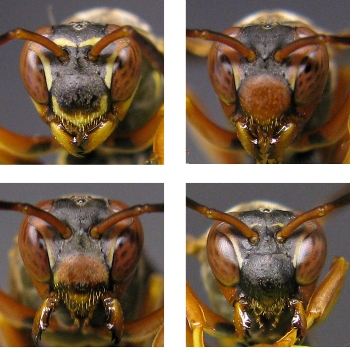 Recent research has shown that some wasps recognize other wasp-faces. Photo by: Elizabeth Tibbetts. |
“If we take the view that lifestyle governs the evolution of intelligent behavior to some extent, there aren’t too many insects whose daily demands on ‘brainwork’ are similarly challenging [as bees]. The combination of social life (with all of the complexities of communication between colony members), flower foraging and its demands on memory as well as spatial navigation to allow reliable return to the home mean that bees are faced with unique challenges that might have forced them to evolve unique cognitive capacities.”
For Chittka, studying bees—and animal intelligence in general—is less about comparing other species to humans and more about exploring an intellectual landscape that functions wholly different than ours.
“It has been clear for decades that many animals (especially our closest relatives) can do some of the things that we consider intelligent in humans, and indeed Darwin was quite aware of that,” Chittka says. “But I think the focus on measuring animals against human standards is a bit one-dimensional and ultimately boring. Vive la difference! Animals’ sensory systems expand into many aspects of the environment that are entirely inaccessible to us,” he explains, adding later that “rather than searching for amusing similarities with humans, it is more promising to launch into the unknown and strive for genuinely novel discoveries. This is more risky, but also potentially more rewarding.”
One example of such discoveries is the bees’ waggle dance. Chittka says that only a few bee species perform this ‘symbolic communication’, whereby bees ‘talk’ to one another in the darkness of a hive.
“For example, a waggle run straight up on the vertical comb means ‘fly in the direction of the sun’. A waggle run straight down means ‘fly in the opposite direction of the sun’, and a waggle run 90 degrees to the right of the ‘up’ direction means ‘fly 90 degrees to the right of the sun’. The duration of the waggle run symbolizes the distance. This means that dancing bees can ‘tell’ other bees where to go, without actually pointing the direction or guiding others to the destination.”
Some insects are surely intelligent, but does that mean they are conscious? Chittka says that much like ‘intelligence’ the designation of consciousness depends on one’s definition. To date science has not yet been able to satisfactorily answer this question in regards to insects.
In a June 2010 interview with mongabay.com, Lars Chittka discusses his work with bee intelligence, other insect intelligence, and the difference (less than you would expect) between small brains and big ones.
AN INTERVIEW WITH LARS CHITTKA
Mongabay: What is your background and what led to your interest in animal intelligence, specifically insect intelligence?
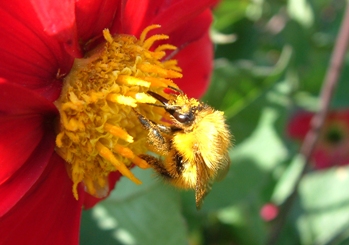 A bumblebee (Bombus pascuorum) in Scotland. Photo by: Lars Chittka. |
Lars Chittka: I wish I could say—”Well, I have always had an interest in insect cognition since my preteen years”—etc—the kind of thing people make up in hindsight when they’re writing biographies. Actually, the choice of field was the result of fortuitous processes—I moved to Berlin in the 1980s because of the culture and nightlife, and, being a biology student, I also needed to find a lab to do a project. It just so happened that the most interesting lab at that university was working on honeybee learning, so that’s where I ended up. That said, I have always been interested in animal behavior and psychology – Freud and Lorenz were among my teenage heroes, right next to Ritchie Blackmore and David Gilmore. They wouldn’t be my first choice now (and I was probably a bit behind the times even in the 1970s), but they’re still better heroes for a teenager than Paris Hilton et al.
Mongabay: Why is the study of animal intelligence important?
Lars Chittka: Many researchers in the field would probably reply “… so we can understand the evolutionary roots of human evolution better.” That might be one reason, but I think we’ve gone as far as we can on that front—it has been clear for decades that many animals (especially our closest relatives) can do some of the things that we consider intelligent in humans, and indeed Darwin was quite aware of that. But I think the focus on measuring animals against human standards is a bit one-dimensional and ultimately boring. Vive la difference! Animals’ sensory systems expand into many aspects of the environment that are entirely inaccessible to us—think magnetoreception, sensitivity to IR, UV and polarized light, ultrasonic hearing etc—it is thus fascinating to contemplate how these animals process the information from the wholly alien worlds that they perceive, and draw interferences about their subjective environments. This is an intellectual challenge in its own right – it needs no applied justification.
BEES
Mongabay: What makes bees good models for researchers?
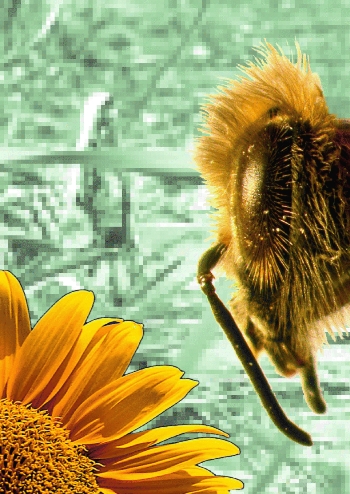 The strange visual world of bees. From journal’s legend: “Although bees see flowers in colour, they do not analyse the colours of the landscape image that moves across the eye as they fly. Their perception of landscape motion is colour-blind; motion vision is driven solely by a single spectral receptor type, the bees’ green receptor. This is reflected in the distance code of the dance: the more green contrast is present in the scene, the further bees ‘think’ they have flown.” Image designed by: Fiola Bock. Source of image: doi:10.1371/journal.pbio.0020216.g002. |
Lars Chittka: There are several aspects. One is that a life-style of central place foraging and flower visitation places incredible demands on cognition, so they’re models for how far you can push a miniature nervous system. Social bees spread out from their nest (or hive) over an area of several square kilometers—but they need to navigate sufficiently skillfully to relocate their nest after foraging bouts that may last over an hour. Not an easy task if you’ve got a brain the size of a pinhead! For comparison, imagine a group of 10 year old school children from an English speaking country—placed in a city where no-one speaks their language—say Tokyo (so they can’t ask for directions) then send them out to explore the town and come back at the end of the day (and don’t give them a map either). How many do you think will return to the starting place at the end of the day…? Plus of course bees need to make economic choices between the offerings from different flower types, memorize the best flowers’ appearance and scents etc. An unbeatable advantage for experimenters is that is that social insect foragers don’t satiate. Many animal behaviorists reward their subjects with food if they’ve done something well. After a few trials, rats, pigeons etc. will sit in the corner, burp, and say ‘Thank you very much, I’ve now had enough to eat and I’m no longer interested in your experiment’. Bees, conversely, go home and make their forage available to the colony—and come right back to the setup with an empty stomach, eager for more action. Finally, for my neuroscientist colleagues, insects’ small nervous systems make it feasible to identify the neural circuitry underpinning behavior on a very fine-grained level.
Mongabay: What are some of the most important discoveries regarding bee intelligence?
Lars Chittka: We have long known that bees can learn the locations of flowers, as well as their colors and odors. However, when I published a manuscript 15 years ago indicating that honeybees might be able to count landmarks, I think no one quite believed it—but in recent years there have been several studies confirming this finding. Martin Giurfa and Mandyam Srinivasan have identified some very impressive abilities in bees in recent years, for example the formation of ‘sameness’ and ‘difference’ concepts. When learning the concept of sameness, honeybees are first shown a sample visual pattern A, then given a choice between A and B, where A is associated with a reward. Thus, bees need to memorize the first pattern and match one of the following pair to it. Moreover, bees can eventually learn a more general rule to ‘choose the same ones’ with entirely different sets of stimuli (for example, pattern C followed by C and D), even if they have not seen these stimuli before. Perhaps even more impressively, they transfer the ‘sameness rule’ to visual stimuli even if it was entrained using olfactory stimuli. And finally, honeybees can learn the inverse concept: ‘choose the different one’, so subjects learnt to always choose the pattern that was not the sample — the ‘odd one’. Adrian Dyer has shown that honeybees can memorize images of human faces, which some people had thought to be a uniquely human ability.
Mongabay: Can you tell us how bees ‘categorize’ items?
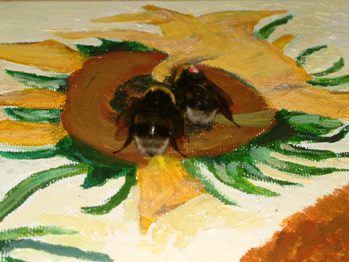 Two bees sit on a copy of Van Gogh’s sunflowers. Photo by: Lars Chittka. |
Lars Chittka: Bees can learn, for example, to categorize visual patterns into symmetrical and asymmetrical ones. After they’ve memorized the rule, they can correctly classify and pattern as belonging to either the one or the other category, even if they’ve never seen it before. Again, this capability is remarkable because it means can’t just store a single pattern in a pixel-by-pixel fashion – they have to extract a rule that links multiple pattern by a common feature. Once memorized, the rule can then be applied to novel objects.
Mongabay: Do you think these intelligent behaviors likely occur in other unstudied species of insect?
Lars Chittka: It’s possible—but if we take the view that lifestyle governs the evolution of intelligent behavior to some extent, there aren’t too many insects whose daily demands on ‘brainwork’ are similarly challenging. The combination of social life (with all of the complexities of communication between colony members), flower foraging and its demands on memory as well as spatial navigation to allow reliable return to the home mean that bees are faced with unique challenges that might have forced them to evolve unique cognitive capacities.
INSECT INTELLIGENCE
Mongabay: Insects can do incredible things, such as build architectural marvels, but how do you distinguish between ‘instinctual behavior’ and ‘intelligence’?
Lars Chittka: You’re right, many impressive behavior patterns are of course more or less hard-wired and governed by instinct. However, nothing in animal behavior makes sense except in the light of learning and so even seemingly highly stereotyped behaviors, such as honeycomb construction and the honeybee dance have learnt components. But at their basis, these behavioral feats are of course evolutionary, not individual innovations. The traditional way of distinguishing innate and learnt behaviors is to explore whether new behaviors can be traced to individual experiences, or whether (in some vertebrates) they might be the result of insight. The cognitive feats described above are of course clearly the result of individual learning. It might be controversial whether rule learning, categorization etc. qualify as intelligence, but of course similar tests are indeed used for IQ tests on human subjects.
Mongabay: What are some surprising recent discoveries regarding insect intelligence?
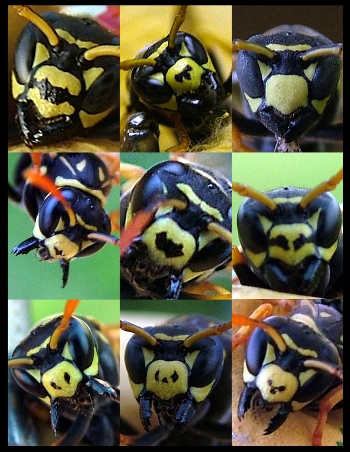 The many faces of wasps. Photo by: Elizabeth Tibbetts. |
Lars Chittka: Outside the honeybees, some outstanding discoveries in recent years were made in some other insects, for example, by Elizabeth Tibbett’s work on individual face recognition in colonies of paper wasps. These wasps have a very intricate hierarchical system, and so they might need individual recognition for a certain Machiavellian intelligence! Similar individual recognition also occurs in some ants, albeit via the olfactory sense.
Mongabay: What is ‘symbolic language’? What are some examples of insects employing symbolic language?
Lars Chittka: There’s really only one example. Among the many 1000 species of bees, only a handful of honeybee species can communicate to one another, in the darkness of the hive, the location where they have found a food bonanza. They do this by using a complicated, repeated motor display called the waggle dance. And indeed they use symbols to indicate distance and direction. For example, a waggle run straight up on the vertical comb means “fly in the direction of the sun”. A waggle run straight down means “fly in the opposite direction of the sun”, and a waggle run 90 degrees to the right of the ‘up’ direction means “fly 90 degrees to the right of the sun”. The duration of the waggle run symbolizes the distance. This means that dancing bees can ‘tell’ other bees where to go, without actually pointing the direction or guiding others to the destination. Nonetheless of course this is not a real ‘language’, because arbitrary content cannot be expressed with arbitrary symbols, as is the case in human language.
Mongabay: Would you call bees or other insects ‘conscious’?
Lars Chittka: It depends on how you define consciousness, and what you accept as a critical test. Many researchers interested in vertebrates hold that animals have consciousness if they can recognize themselves in a mirror. The rationale seems to be that you’re conscious if you recognize yourself as a unique entity, with thoughts, intentions and feelings distinct from others etc—but this is a spectacularly uncritical test. What’s shown in these tests is simply that individuals recognize their own appearance. However, recognition of one’s own visual appearance is just a special case of recognition of other individuals, and some insects can certainly recognize each other individually (see above). Others have said that predicting the outcome of one’s own actions equates to consciousness. Scientists working in robotics and neural networks have shown that such predictions can be made with relatively few neurons, i.e. numbers that could certainly be accommodated in an insect brain. Nonetheless I think at this stage we lack the critical tests to answer the question of consciousness in insects.
BRAIN SIZE
Mongabay: With small brains, how do insects manage such complex behaviors?
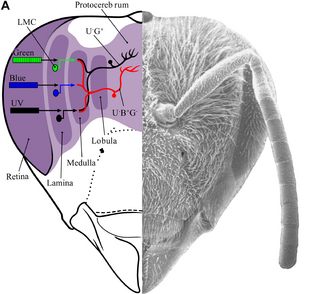 Front view of a bee’s head showing essential features of color processing in the brain. Image obtained using a scanning electron micrograph. Image source: Chittka L, Brockmann A (2005) Perception Space—The Final Frontier. PLoS Biol 3(4): e137. doi:10.1371/journal.pbio.0030137. |
Lars Chittka: Should we be surprised? Perhaps we’re only surprised since we as humans have relatively large brains, some of us are relatively intelligent, and so we think that large brains equal complexity. However, the neural underpinnings of many behaviors in insects are well understood, and it turns out that many routines require only a very limited number of neurons. New behaviors can be generated by activating muscles in a different sequence, but this might again require only very few additional neurons. Neural network analyses show that many tasks, like categorization, or counting, also require only very small neuron numbers.
Mongabay: Why is it important that larger brains do not necessarily mean increased intelligence?
Lars Chittka: Larger brains are, at least partly, a consequence of larger neurons that are necessary in large animals due to basic biophysical constraints. They also contain greater replication of neuronal circuits, adding precision to sensory processes, detail to perception, more parallel processing and enlarged storage capacity (in other words, more of the same). Larger brains in animals with larger carrying capacity facilitate, but do not necessarily automatically generate, the segregation, conversion and addition of more (and more specialized) modules that might ultimately be used for novel cognitive functions. Ultimately, the similarity in cognitive processing output despite huge differences in size of nervous systems might help answer the question of the minimum necessary circuitry for complex tasks such as categorization, counting, and concept learning.
Mongabay: What are the advantages of big brains then?
Lars Chittka: Yes, after all of the above, one might wonder why anything needs bigger brains than insects in the first place! There is no question that larger brains allow higher storage capacity—but at this level, that’s no different to having a bigger hard drive, rather than a better processor. However, having more stored information also means that you can browse a larger library to come of with solutions to novel problems. Larger brains might also allow you to process more information in parallel, rather than sequentially, and to add new modules with new specialized computational functions.
Mongabay: Most people view insects as hardwired pests. Should we change that view considering recent discoveries?
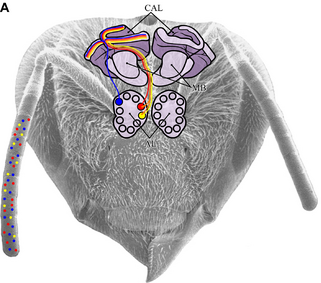 The honeybee brain highlighting its odor processing. Some 60,000 odorant receptor cells are distributed along the bees’ antenna. These belong to a number of different types (shown here with different colors), and each responds to a different set of chemicals. Image source: Chittka L, Brockmann A (2005) Perception Space—The Final Frontier. PLoS Biol 3(4): e137. doi:10.1371/journal.pbio.0030137. |
Lars Chittka: Already in 1900, Buttel-Reepen asked whether honeybees are mere reflex machines—and emphatically denied that claim. Over the last century, we have seen a fundamental change in perspective on the learning capacities of insects, and there a now several credible lines of evidence that insects are capable of cognitive feats that had previously been ascribed only to “higher” vertebrates. So yes, I think we can safely bin this notion.
Mongabay: How does new understanding about insect intelligence help us better understand the evolution of the brain?
Lars Chittka: Almost all of the molecular components of neurons—ion channels, neurotransmitters, pumps, exchangers and G-protein receptors—are present in both vertebrates and insects, and thus, presumably in their common ancestor. Ultimately, we will understand brain evolution better if we appreciate that cognitive performance can arise early on and in small nervous systems, or relatively easily by convergence based on environmental challenges.
Mongabay: Where would you like to see this research go in the future?
Lars Chittka: We need to understand the neural circuitry that underpins cognitive processes in more detail. The fashionable brain imaging tools whose imagery you see in the daily press (“This is the area that lights up when a mass murderer thinks about Christmas” etc) do not offer the required kind of resolution. The level of resolution is so course-grained that each voxel (the 3D equivalent of the pixel in these scan images) is larger than the entire brains of multiple insects together. What is required is a better analysis of the activity of individual neurons, their synaptic connections with other neurons, and a temporal mapping of neural activation in entire networks.
Mongabay: What advice would you give a student interested in pursuing animal intelligence?
Lars Chittka: The vast majority of research on animal intelligence is essentially asking the question “How human are animals?” Essentially researchers are copying concepts and methods from psychology, and see whether they can adapt the procedures so that their favorite animal can pass the test. Cynics might observe, however, that the finding that “animals can do it, too” generates plenty of press coverage, but is perhaps in itself neither intellectually challenging nor scientifically insightful (beyond the identification of evolutionary convergence). In fact, one might argue that some of the most exciting discoveries about unique insect behaviors would never have been made, had this approach been used throughout. Would von Frisch ever have discovered the bee “dance language” if he had deliberately set out to find a form of “language” in the animal kingdom? Probably not—and in fact the question of definition (whether this symbolic communication warrants the term “dance” or in fact a “language”) is perhaps secondary to the fascination with the uniqueness of this communication system. Rather than searching for amusing similarities with humans, it is more promising to launch into the unknown and strive for genuinely novel discoveries. This is more risky, but also potentially more rewarding.
Related articles
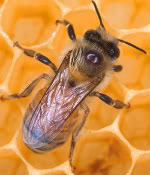
(01/29/2009) Plato once said: “numbers are the highest degree of knowledge: it is knowledge itself.” By Plato’s standards researchers have just discovered that the honey bee is a knowledgeable insect indeed. The honey bee can count to three in an instant according to a new study in the online journal PLoS ONE. Using dots and other abstract symbols, scientists from the Vision Centre in Australia tested whether the honey bees had the ability to count items in their environment.
Insect intelligence: paper wasps display strong long-term memory
(12/01/2008) A recent study in Current Biology finds that paper wasps are capable of remembering rivals a week after initially meeting. As a highly social insect, the discovery proves that the paper wasps’ social interactions are based on applied memory rather than simple instinct. The finding overturns many ideas about the intelligence of insects.
Scientists discover world’s first amphibious insects: Hawaiian caterpillars
(03/22/2010) Scientists have never before discovered a truly amphibious insect until now: writing in the Proceedings of the National Academy of Sciences researchers have announced the discovery of 12 species of Hyposmocoma moths in the Hawaiian islands which they consider truly amphibious—that is a species able to survive both on land and underwater indefinitely.
Cricket mothers warn offspring about spiders before they hatch
(02/21/2010) Cricket mothers are long gone by the time their infants hatch, so one would assume that cricket parents have little effect on their offspring’s behavior. Not so, according to a new study in the American Naturalist which proves that mother crickets have the potential to teach their offspring—while still in their eggs—about the hazards of spiders.
Sophisticated flying methods allow insects to hitchhike on fast winds
(02/04/2010) Researchers have long been fascinated by how insects migrate thousands of kilometers, for example from Britain to the Mediterranean. A new study, published in Science shows that although tiny, insects are not at the mercy of winds as expected. Instead they employ sophisticated flight behaviors to use fast winds to their advantage.
Loss in biodiversity may be killing bees
(01/20/2010) A decline in diverse plants species on which to feed may be causing a similar decline in bee survival, according to a new paper in Biology Letters.
Researchers catch new cricket species going where no cricket has gone before
(01/13/2010) East of Madagascar, on the small island of Reunion, researchers have made a remarkable discovery: a cricket that pollinates an orchid. The cricket, which is also a species new to science, was caught by a motion sensitive camera pollinating the orchid, Angraecum cadetii. The genus Angraecum orchid is usually pollinated by moths, but cadetti‘s nectar-spur opening is just the right shape for the cricket, known as the ‘raspy cricket’.
Moths defend against bats by ‘jamming’ sonar
(07/16/2009) Researchers have discovered a species of tiger moth that eludes bats by jamming their echolocation with ultrasonic clicks, a discovery that adds to the list of defensive mechanisms that insects use to defend themselves against bats. The study is published in the journal Science.
Dragonflies migrate 14,000-18,000 km from India to S. Africa
(07/16/2009) Millions of dragonflies migrate thousands of kilometers across the Indian Ocean from southern India to Africa, reports the BBC.
Butterfly tricks ants by mimicking their queen’s vocalizations
(02/05/2009) With cohesive hierarchical societies and a number of communication techniques, ants have been able to conquer a wide variety of ecosystems with great success. However, according to a recent paper in Science ants’ highly structured society at times comes with a price. A number of insects have evolved means to covertly infiltrate the ants’ society and live off their work and bounty by closely mimicking various ant communication methods. While scientists believe that these parasitical insects largely mimic ant communications like chemical exchange and physical contact—such as touching antennae—the study, however, discovered a butterfly which succeeds in infiltrating the highest echelons of ant society by vocalizing like a queen.
For Australian beetles bigger is better; while American beetles don’t care about size
(09/03/2008) Researchers have discovered a dung beetle that may be evolving into separate species in a few decades rather than thousands or millions of years. Separated geographically, sub-populations of the species show large differences in the size of their genitalia and horns. Such distinctions could create new species in a short time, because beetles with largely different genitalia cannot successfully mate.
Researchers discover “artistic” moth in Panama
(07/29/2008) Researchers have discovered a new species of Bagworm Moth that wraps its eggs individually in “beautiful cases” fashioned from its golden abdominal hairs, according to a new paper published in the Annals of the Entomology Society of America. The behavior is unique among insects.